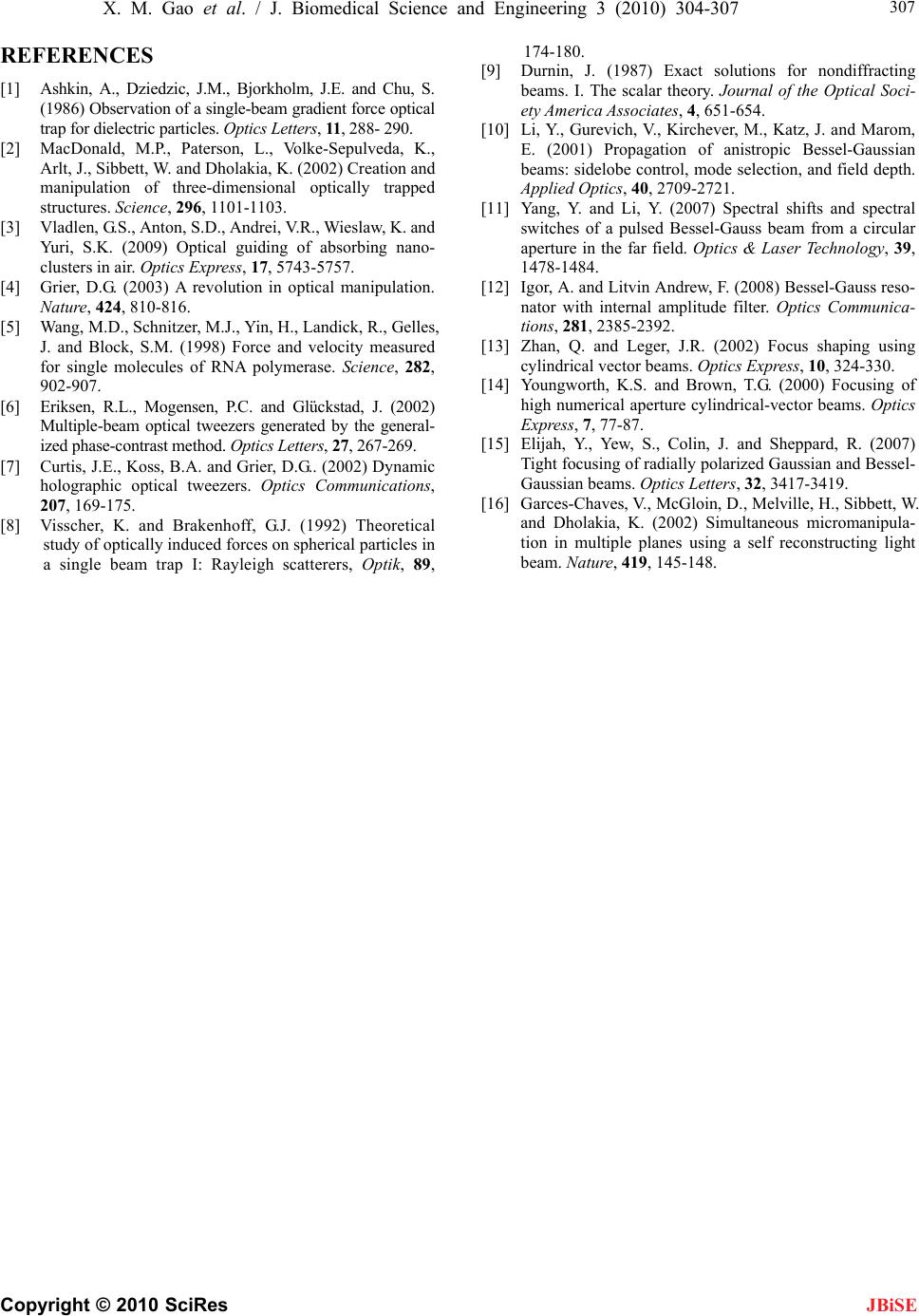
X. M. Gao et al. / J. Biomedical Science and Engineering 3 (2010) 304-307
Copyright © 2010 SciRes
307
JBiSE
REFERENCES
[1] Ashkin, A., Dziedzic, J.M., Bjorkholm, J.E. and Chu, S.
(1986) Observation of a single-beam gradient force optical
trap for dielectric particles. Optics Letters, 11, 288- 290.
[2] MacDonald, M.P., Paterson, L., Volke-Sepulveda, K.,
Arlt, J., Sibbett, W. and Dholakia, K. (2002) Creation and
manipulation of three-dimensional optically trapped
structures. Science, 296, 1101-1103.
[3] Vladlen, G.S., Anton, S.D., Andrei, V.R., Wieslaw, K. and
Yuri, S.K. (2009) Optical guiding of absorbing nano-
clusters in air. Optics Express, 17, 5743-5757.
[4] Grier, D.G. (2003) A revolution in optical manipulation.
Nature, 424, 810-816.
[5] Wang, M.D., Schnitzer, M.J., Yin, H., Landick, R., Gelles,
J. and Block, S.M. (1998) Force and velocity measured
for single molecules of RNA polymerase. Science, 282,
902-907.
[6] Eriksen, R.L., Mogensen, P.C. and Glückstad, J. (2002)
Multiple-beam optical tweezers generated by the general-
ized phase-contrast method. Optics Letters, 27, 267-269.
[7] Curtis, J.E., Koss, B.A. and Grier, D.G.. (2002) Dynamic
holographic optical tweezers. Optics Communications,
207, 169-175.
[8] Visscher, K. and Brakenhoff, G.J. (1992) Theoretical
study of optically induced forces on spherical particles in
a single beam trap I: Rayleigh scatterers, Optik, 89,
174-180.
[9] Durnin, J. (1987) Exact solutions for nondiffracting
beams. I. The scalar theory. Journal of the Optical Soci-
ety America Associates, 4, 651-654.
[10] Li, Y., Gurevich, V., Kirchever, M., Katz, J. and Marom,
E. (2001) Propagation of anistropic Bessel-Gaussian
beams: sidelobe control, mode selection, and field depth.
Applied Optics, 40, 2709-2721.
[11] Yang, Y. and Li, Y. (2007) Spectral shifts and spectral
switches of a pulsed Bessel-Gauss beam from a circular
aperture in the far field. Optics & Laser Technology, 39,
1478-1484.
[12] Igor, A. and Litvin Andrew, F. (2008) Bessel-Gauss reso-
nator with internal amplitude filter. Optics Communica-
tions, 281, 2385-2392.
[13] Zhan, Q. and Leger, J.R. (2002) Focus shaping using
cylindrical vector beams. Optics Express, 10, 324-330.
[14] Youngworth, K.S. and Brown, T.G. (2000) Focusing of
high numerical aperture cylindrical-vector beams. Optics
Express, 7, 77-87.
[15] Elijah, Y., Yew, S., Colin, J. and Sheppard, R. (2007)
Tight focusing of radially polarized Gaussian and Bessel-
Gaussian beams. Optics Letters, 32, 3417-3419.
[16] Garces-Chaves, V., McGloin, D., Melville, H., Sibbett, W.
and Dholakia, K. (2002) Simultaneous micromanipula-
tion in multiple planes using a self reconstructing light
beam. Nature, 419, 145-148.